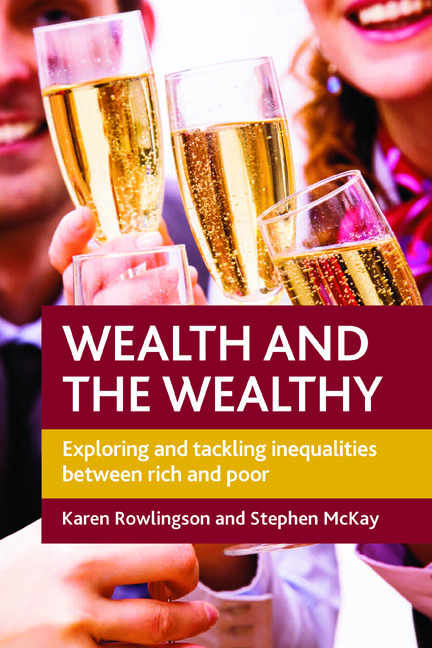Book contents
- Frontmatter
- Dedication
- Contents
- List of tables and figures
- Acknowledgements
- About the authors
- Introduction
- one Why wealth matters
- two Why the wealthy matter
- three What is wealth and who are the wealthy?
- four The distribution of wealth
- five The rich, the richer and the richest
- six Towards a comprehensive policy on assets
- seven Social policy and the wealthy
- Conclusions
- References
- Index
five - The rich, the richer and the richest
Published online by Cambridge University Press: 01 September 2022
- Frontmatter
- Dedication
- Contents
- List of tables and figures
- Acknowledgements
- About the authors
- Introduction
- one Why wealth matters
- two Why the wealthy matter
- three What is wealth and who are the wealthy?
- four The distribution of wealth
- five The rich, the richer and the richest
- six Towards a comprehensive policy on assets
- seven Social policy and the wealthy
- Conclusions
- References
- Index
Summary
Introduction
In recent years there has been growing concern about the concentration of wealth at the top. But, as we saw in Chapter Three, there is no agreement about who is ‘rich’ or ‘wealthy’. Rather than allow this stumbling block to derail any discussion of this group, we use a range of measures in this chapter to investigate three groups. The first group is ‘the rich’ who we define as the top 10 per cent of the income/asset distribution. The top 10 per cent, however, do not necessarily see themselves as receiving high incomes. let alone as privileged or wealthy or rich, as they are often not aware of how high they are in the wider distribution of income and assets. Indeed, as we saw in Chapter Two, people at the top often place themselves in the middle of the economic distribution (Rowlingson et al, 2010). We define the ‘rich’ as the top 10 per cent because, as we saw in Chapter Four, this group's income and wealth sets them apart from the rest of society. The distribution of income and assets increases quite considerably at this level, which means that this group has a great deal more economic resources than the rest of society. For example, the top 10 per cent own 100 times more wealth than the bottom 10 per cent, and they own 50 times more than the average (median). And as we shall see in this chapter, it enables them to establish private lifestyles and modes of consumption. This group also has the ability to exclude themselves from some elements of society as they can afford private forms of welfare such as fee-paying schools and private health insurance. This fits in with John Scott's conceptualisation of the privileged (Scott, 1994).
Many of the group we label ‘the rich’ may not consider themselves wealthy, but the group we label the ‘richer’ (top 1 per cent) are much more likely to appreciate their economic power and status. This group have pulled away from everyone else in the last decade or so and we therefore consider them on their own as a key ‘richer’ group.
- Type
- Chapter
- Information
- Wealth and the WealthyExploring and Tackling Inequalities between Rich and Poor, pp. 115 - 144Publisher: Bristol University PressPrint publication year: 2011



